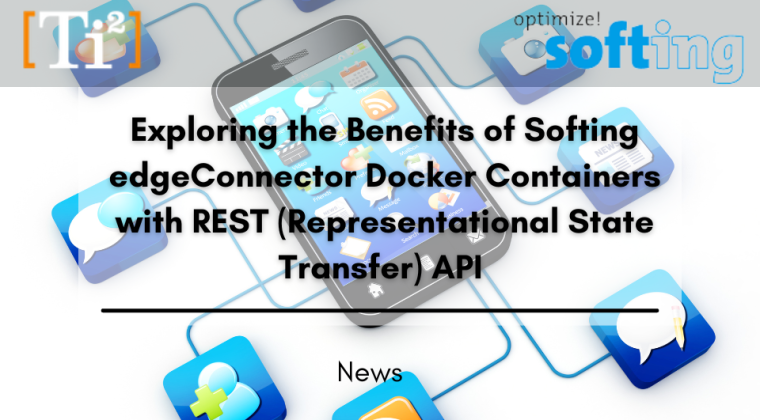
In June 2022, Softing Industrial Automation, a world-leading provider of industrial communication products and technologies for manufacturing and process automation released their new feature of edgeConnector product from Softing’s dataFEED range. It now includes a REST (Representational State Transfer) API, making integration into configuration platforms easier. In addition, a new licensing model offers more flexibility when deploying individual products.
Dockers make it easy to build and run applications using containers. The Docker-Container applications offer flexible deployment options, for example on devices running Azure IoT Edge or AWS IoT Greengrass.
The REST API in version 3.0 of Softing’s edgeConnector products makes local or remote configuration much easier for users. The product family currently includes edgeConnector Siemens, edgeConnector 840D and edgeConnector Modbus.
The software modules are based on Docker technology and provide access to process data in SIMATIC S7, SINUMERIK 840D and Modbus TCP controllers. In the past, a separate login via the local configuration interface was necessary for each product. This is now done by the new edgeConfigurator, which allows all edgeConnectors to be accessed via the REST API. The edgeConfigurator is also based on Docker technology and is used in parallel with the edgeConnectors.
The configurator can be deployed on-premise or additionally in the Microsoft Azure cloud, allowing REST API access from the cloud to the edgeConnectors’ on-premise environment. Using the REST API, edgeConnectors can now be configured more easily from a third-party application.
According to Dr. Roy Fielding in his 2000 Doctorate Dissertation, REST also provides an incredible layer of flexibility. REST has the ability to handle multiple types of calls, return different data formats and even change structurally with the correct implementation of hypermedia since data is not tied to methods and resources.
With REST API, no library support is needed as typically used over HTTP. It returns data without exposing methods and supports any content type (XML and JSON used primarily), uses single resources for multiple actions, and typically uses explicit HTTP Action Verbs (CRUD) while documentation can be supplemented with hypermedia. However, it’s true that often, REST API is more difficult for developers to use with its complexities.
In REST, the different layers of architecture create a more scalable and modular application with load balancing and routing. It encapsulates the legacy system and moves less commonly accessed functionality to a shared intermediary, giving freedom to move systems in and out of the tech and service architecture while keeping more modern and common components on the surface. This increases flexibility and longevity.
With REST API’s layered system, attacks at proxy layers or within other layers are easily prevented from getting to the actual server with a single point of access. This is a substantial security benefit as you are able to keep vulnerable aspects of the architecture behind a firewall and without direct interaction. Although certain security checks may fail or be bypassed, more security is still able to be implemented to prevent damaging attacks.
In addition, the new license model of version 3.0 distinguishes between Basic (edgeConnector Modbus), Advanced (edgeConnector Modbus and edgeConnector Siemens) and Premium (all edgeConnector products). The licenses no longer refer to data points; instead they only account for the connected controllers. The user can choose between license options of 1, 5, 10 and 20 connections.
Another notable benefit of Softing EdgeConnector’s new licensing model is that it helps to streamline operations throughout all stages of the application lifecycle. EdgeConnector’s container-based licensing model is designed for on-premise, hybrid, and public cloud environments. This allows businesses to choose the deployment model that best meets their needs and requirements.
Lastly, being client-server in terms of applications and stateless, REST APIs can also increase request overhead by handling large loads of incoming and outbound data as it is designed to encourage the storage of cacheable data. This indicates that data can be stored up to a certain timeframe and in case data needs to be real-time, the response should not be cached. This will greatly reduce the number of interactions via API, reduce internal server usage, and provide the necessary tools to provide fast and efficient apps.
With easy integration into Industrie 4.0 and Industrie 5.0, IoT cloud, and big data solutions, Softing’s products are also compatible with CODESYS’ IEC 61131-3 automation software for engineering control system.
Ti2 has been the main Softing and CODESYS Distributor for Australia and New Zealand since 2000, with vast skill and prowess in a wide range of quality industrial automotive, automation, and information products and services. Using genuine open standards and technologies for industrial solutions we are able to reduce the overall cost of ownership.
Please click here to email us your inquiry or quote request, we would like to hear from you.
To learn more about what we do and how we can help your edge computing requirement click projects, products & services.
Ti2 is currently very focused on working with its global partners to secure stock and avoid long delay times in delivering products to their customers. Together with our trusted partners, we are here to provide solutions.
